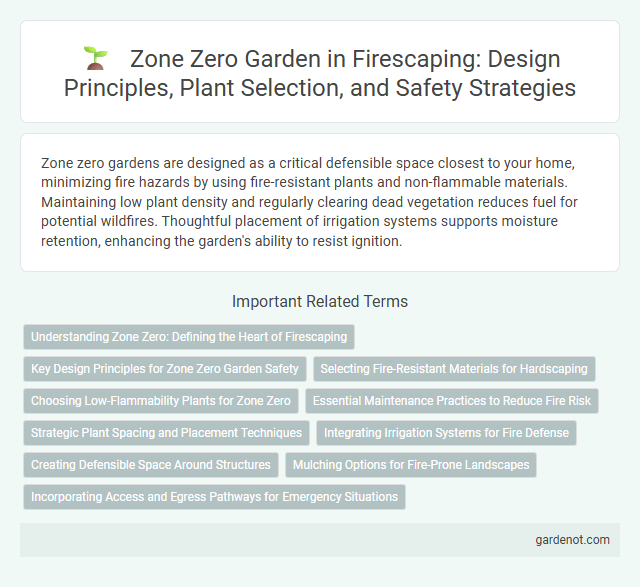Zone zero gardens are designed as a critical defensible space closest to your home, minimizing fire hazards by using fire-resistant plants and non-flammable materials. Maintaining low plant density and regularly clearing dead vegetation reduces fuel for potential wildfires. Thoughtful placement of irrigation systems supports moisture retention, enhancing the garden's ability to resist ignition.
Understanding Zone Zero: Defining the Heart of Firescaping
Zone Zero represents the immediate area surrounding a structure where fire hazards must be minimized through strategic landscaping and material selection. This zone typically extends 5 feet from the building's foundation and requires non-flammable plants, hardscaping features, and routine maintenance to eliminate potential ignition sources. Proper management of Zone Zero is critical in firescaping to create a defensible space that protects homes from wildfire exposure.
Key Design Principles for Zone Zero Garden Safety
Zone Zero in firescaping refers to the immediate perimeter surrounding a structure, typically within 5 feet, where fire-resistant landscaping elements are essential to prevent ignition. Key design principles include using non-flammable materials such as gravel or stone, maintaining minimal and well-irrigated vegetation, and selecting fire-resistant plants with low resin and oil content. Ensuring clear separation between plants and combustibles, combined with regular maintenance, significantly enhances safety in Zone Zero gardens.
Selecting Fire-Resistant Materials for Hardscaping
Zone zero garden hardscaping requires selecting fire-resistant materials such as non-combustible stone, concrete pavers, and metal edging to minimize fire risk near structures. Incorporating materials with low heat absorption and ignition points enhances the garden's defensible space by preventing ember ignition and heat transfer. Prioritizing these fire-resistant options supports safer landscaping by creating effective barriers against wildfire spread.
Choosing Low-Flammability Plants for Zone Zero
Selecting low-flammability plants for Zone Zero is crucial in effective firescaping, as this area directly borders structures and demands vegetation that resists ignition. Succulents, herbaceous perennials like liriope, and deciduous trees with high moisture content are ideal choices, reducing fire risk while maintaining aesthetic value. Incorporating plants with minimal resin, oil, or wax content further decreases combustibility, strengthening the garden's fire defense.
Essential Maintenance Practices to Reduce Fire Risk
Zone zero garden requires regular removal of dead leaves, twigs, and other combustible debris to minimize fire hazards. Maintaining well-irrigated, fire-resistant plants and pruning branches to prevent fuel ladders significantly reduces ignition potential. Using non-flammable mulch and inspecting irrigation systems ensures optimal plant health and lowers fire risk in the most critical landscape area.
Strategic Plant Spacing and Placement Techniques
Zone zero garden employs strategic plant spacing and placement techniques to create effective defensible space against wildfires. Plants are arranged with adequate separation to minimize heat transfer and reduce fuel continuity, prioritizing fire-resistant species in critical areas near structures. Proper layering and reducing plant density in zone zero enhance firebreaks and increase garden resilience.
Integrating Irrigation Systems for Fire Defense
Zone zero gardens play a critical role in firescaping by integrating efficient irrigation systems designed specifically for fire defense. These systems often use drip irrigation or smart controllers to maintain optimal soil moisture in high-risk areas, reducing flammable vegetation and creating a defensible space around structures. Properly installed, these irrigation systems help slow fire spread and protect homes by keeping zone zero plants healthy and less combustible.
Creating Defensible Space Around Structures
Zone zero garden focuses on creating defensible space by maintaining a clear, low-flammability buffer immediately surrounding structures, typically within 5 feet. This space is designed to minimize ignition risk by using fire-resistant plants, non-combustible mulch, and regular removal of dead vegetation. Implementing Zone zero garden strategies significantly reduces the likelihood of wildfire damage to buildings by interrupting fuel continuity and limiting heat transfer.
Mulching Options for Fire-Prone Landscapes
Zone zero gardens require mulching options that minimize flammability to enhance wildfire resistance. Inorganic mulches such as gravel or decomposed granite provide a non-combustible barrier, reducing the risk of ignition near structures. Organic mulches like shredded bark should be avoided or replaced frequently as they can increase fire fuel load.
Incorporating Access and Egress Pathways for Emergency Situations
Zone zero garden design emphasizes clear, unobstructed access and egress pathways to facilitate swift evacuation and emergency response. Pathways are constructed using non-flammable materials such as gravel or concrete to prevent fire spread and maintain safe routes. Ensuring wide, well-marked, and regularly maintained access points enhances firefighter entry and occupant safety during wildfire events.
Zone zero garden Infographic

 gardenot.com
gardenot.com